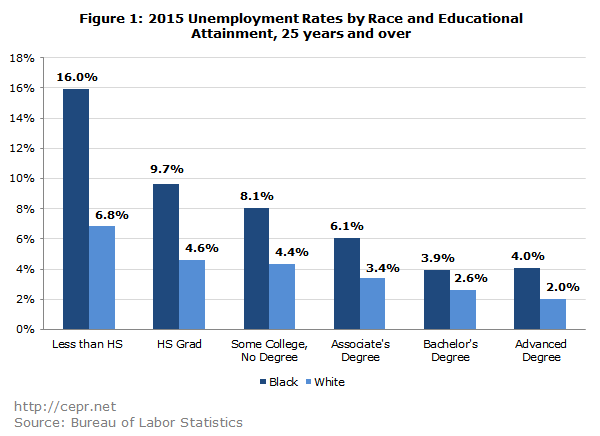March 03, 2016
In 2015, the unemployment rate for black Americans aged 25 and older was 7.8 percent. For white Americans, it was just 3.8 percent. This large gap in unemployment rates persists even when controlling for educational attainment.
Figure 1 shows the average 2015 unemployment rates by race and educational attainment. The black unemployment rate is considerably higher than the white rate within each educational group.

Last year the black unemployment rate would have been 7.3 percent — 3.5 percentage points higher than the white unemployment rate, and just half a percentage point lower than the actual black unemployment rate — if black workers had the same educational attainment as white workers, as shown in Figure 2.

Figure 3 shows the actual black unemployment rate, the black unemployment rate adjusted for education, and the white unemployment rate for workers aged 25 and older from 1994 to 2015. The education-adjusted black unemployment rate is only slightly lower than the actual black unemployment rate for all years, indicating that educational inequality plays only a small role in the black-white unemployment gap.

A more significant factor behind the gap is the cyclical strength of the economy. The black unemployment rate has traditionally been twice as high as the white unemployment rate. But while the ratio of the black unemployment rate to the white rate tends to stay constant, the gap does not. For instance, if the white unemployment rate is 3 percent, then the black unemployment rate will typically be 6 percent; the black-white unemployment gap will therefore be 3 percentage points. However, if the white unemployment rate rises to 7 percent, the black unemployment rate will jump to 14 percent, and the black-white unemployment gap will rise from 3 to 7 percentage points.
The same general trend holds for the subset of the population aged 25 and older. Between 1994 and 2015, the average annual unemployment rate for blacks was about twice the rate for whites. The average ratio of the education-adjusted black rate to the white rate was just over 1.84, indicating that in a normal labor market, educational differences explain just under 15 percent of the black-white unemployment gap.






